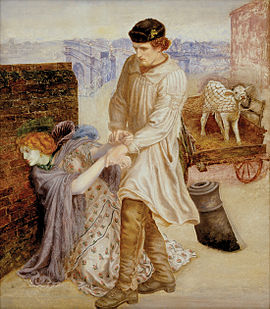
Ford Madox Brown was a British painter of moral and historical subjects, notable for his distinctively graphic and often Hogarthian version of the Pre-Raphaelite style. Arguably, his most notable painting was Work (1852–1865). Brown spent the latter years of his life painting the twelve works known as The Manchester Murals, depicting Mancunian history, for Manchester Town Hall.
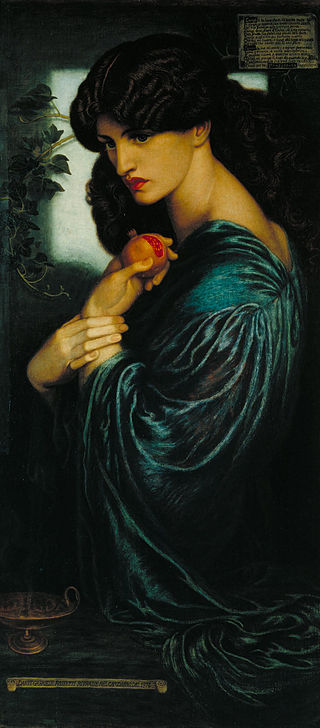
The Pre-Raphaelite Brotherhood was a group of English painters, poets, and art critics, founded in 1848 by William Holman Hunt, John Everett Millais, Dante Gabriel Rossetti, William Michael Rossetti, James Collinson, Frederic George Stephens and Thomas Woolner who formed a seven-member "Brotherhood" partly modelled on the Nazarene movement. The Brotherhood was only ever a loose association and their principles were shared by other artists of the time, including Ford Madox Brown, Arthur Hughes and Marie Spartali Stillman. Later followers of the principles of the Brotherhood included Edward Burne-Jones, William Morris and John William Waterhouse.

Gabriel Charles Dante Rossetti, generally known as Dante Gabriel Rossetti, was an English poet, illustrator, painter, translator, and member of the Rossetti family. He founded the Pre-Raphaelite Brotherhood in 1848 with William Holman Hunt and John Everett Millais. Rossetti inspired the next generation of artists and writers, William Morris and Edward Burne-Jones in particular. His work also influenced the European Symbolists and was a major precursor of the Aesthetic movement.
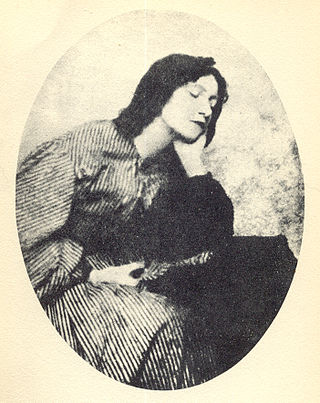
Elizabeth Eleanor Siddall, better known as Elizabeth Siddal, was an English artist, art model, and poet. Siddal was perhaps the most significant of the female models who posed for the Pre-Raphaelite Brotherhood. Their ideas of female beauty were fundamentally influenced and personified by her. Walter Deverell and William Holman Hunt painted Siddal, and she was the model for John Everett Millais's famous painting Ophelia (1852). Early in her relationship with Dante Gabriel Rossetti, Siddal became his muse and exclusive model, and he portrayed her in almost all his early artwork depicting women.

Fanny Cornforth was an English artist's model, and the mistress and muse of the Pre-Raphaelite painter Dante Gabriel Rossetti. Cornforth performed the duties of housekeeper for Rossetti. In Rossetti's paintings, the figures modelled by Fanny Cornforth are generally rather voluptuous, differing from those of other models such as Alexa Wilding, Jane Morris and Elizabeth Siddal.

The Delaware Art Museum is an art museum located on the Kentmere Parkway in Wilmington, Delaware, which holds a collection of more than 12,000 objects. The museum was founded in 1912 as the Wilmington Society of the Fine Arts in honor of the artist Howard Pyle. The collection focuses on American art and illustration from the 19th to the 21st century, and on the English Pre-Raphaelite Brotherhood movement of the mid-19th century.

A Vision of Fiammetta is an oil painting created by Dante Gabriel Rossetti, in the Pre-Raphaelite style, created in 1878. The painting was one half of one of Rossetti's "double works", accompanying his Ballads and Sonnets (1881). Maria Spartali Stillman modelled for the painting. The subject of painting is Boccaccio's muse named Fiammetta.

"The Blessed Damozel" is perhaps the best known poem by Dante Gabriel Rossetti, as well as the title of his painting illustrating the subject. The poem was first published in 1850 in the Pre-Raphaelite journal The Germ. Rossetti subsequently revised the poem twice and republished it in 1856, 1870 and 1873.

Mary Magdalene is a Pre-Raphaelite oil-on-panel painting by the British artist Frederick Sandys, executed in 1858–1860. Mary Magdalene was the only figure from the Bible that Sandys ever painted. Having sharp features reminiscent of Lizzie Siddal, Mary is depicted in front of a patterned forest-green damask. She holds an alabaster ointment cup, a traditional attribute which associates her with the unnamed sinful woman who anointed Jesus' feet in Luke 7:37. Like other Pre-Raphaelite painters, Frederick Sandys gave Magdalene a sensual look.
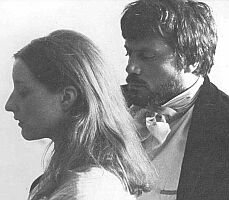
Dante's Inferno: The Private Life of Dante Gabriel Rossetti, Poet and Painter is a 1967 British 35 mm docudrama film directed by Ken Russell and first screened on BBC1 on 22 December 1967 as part of Omnibus. It quickly became a staple in cinemas in retrospectives of Russell's work.
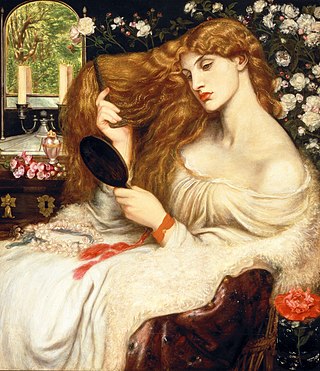
Lady Lilith is an oil painting by Dante Gabriel Rossetti first painted in 1866–1868 using his mistress Fanny Cornforth as the model, then altered in 1872–73 to show the face of Alexa Wilding. The subject is Lilith, who was, according to ancient Judaic myth, "the first wife of Adam" and is associated with the seduction of men and the murder of children. She is shown as a "powerful and evil temptress" and as "an iconic, Amazon-like female with long, flowing hair."
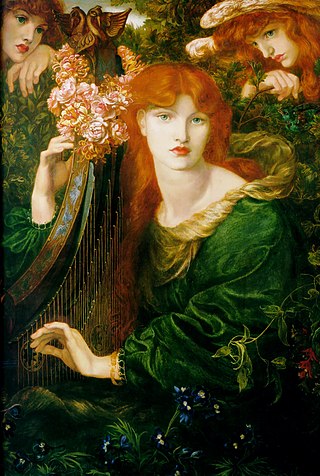
Alexa Wilding was one of the favourite models of the Pre-Raphaelite artist Dante Gabriel Rossetti, featuring in some of his finest paintings of the later 1860s and 1870s. She sat for more of his finished works than any other of his more well-known muses, including Elizabeth Siddall, Jane Morris and Fanny Cornforth.

Pia de' Tolomei is an oil painting on canvas by English artist Dante Gabriel Rossetti, painted around 1868 and now in the Spencer Museum of Art, on the campus of the University of Kansas in Lawrence, Kansas.

Proserpine is an oil painting on canvas by English artist and poet Dante Gabriel Rossetti, painted in 1874 and now in Tate Britain. Rossetti began work on the painting in 1871 and painted at least eight separate versions, the last only completed in 1882, the year of his death. Early versions were promised to Charles Augustus Howell. The painting discussed in this article is the so-called seventh version commissioned by Frederick Richards Leyland, now at the Tate Gallery, with the very similar final version now at the Birmingham Museum and Art Gallery.

Love's Messenger is an 1885 watercolor by Marie Spartali Stillman in which a dove has just carried a love letter to a woman standing in front of an open window. She wears a red rose, and has just put down her embroidery of a blind-folded Cupid.

Mnemosyne, also titled Lamp of Memory and Ricordanza, is an oil painting by Dante Gabriel Rossetti begun in 1875 or early 1876 and completed in 1881. Jane Morris was the model, and Frederick Richards Leyland bought the painting in 1881 and displayed it in his drawing room with five other Rossetti "stunners." At about the same time Rossetti, a founder of the Pre-Raphaelite Brotherhood, was painting Astarte Syriaca, a larger painting completed in 1877 with Morris in a very similar pose.

Veronica Veronese is an oil painting by Dante Gabriel Rossetti painted in 1872 with Alexa Wilding as the model. The painting was conceived as a companion to Lady Lilith. Rossetti sold the painting to one of his best clients, shipping magnate Frederick Richards Leyland. In 1923 it was acquired by the estate of Samuel Bancroft which donated it in 1935 to the Delaware Art Museum.

Monna Rosa is the title of two oil paintings by Dante Gabriel Rossetti, both portraits of Frances Leyland, the wife of shipping magnate Frederick Richards Leyland, a regular patron of Rossetti. The earlier and smaller painting was completed in 1862 and its whereabouts is now unknown. The second was completed in 1867 and is now in a private collection.

Water Willow is an 1871 oil painting by Dante Gabriel Rossetti. It depicts Jane Morris in the river landscape near Kelmscott Manor, with the manor in the left background and Kelmscott Church below the hill to the right.

Fanny Eaton was a Jamaican-born artist's model and domestic worker. She is best known as a model for the Pre-Raphaelite Brotherhood and their circle in England between 1859 and 1867. Her public debut was in Simeon Solomon's painting The Mother of Moses, which was exhibited at the Royal Academy in 1860. She was also featured in works by Dante Gabriel Rossetti, John Everett Millais, Joanna Mary Boyce, Rebecca Solomon, and others.
